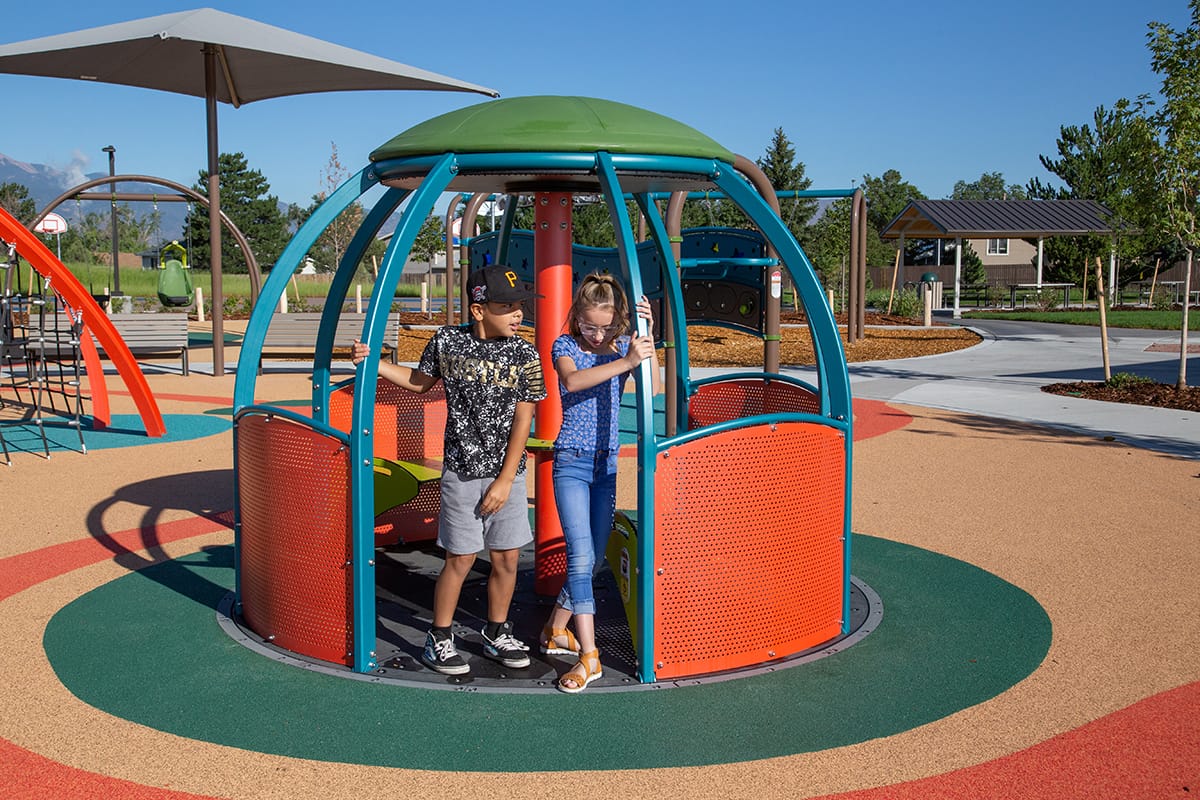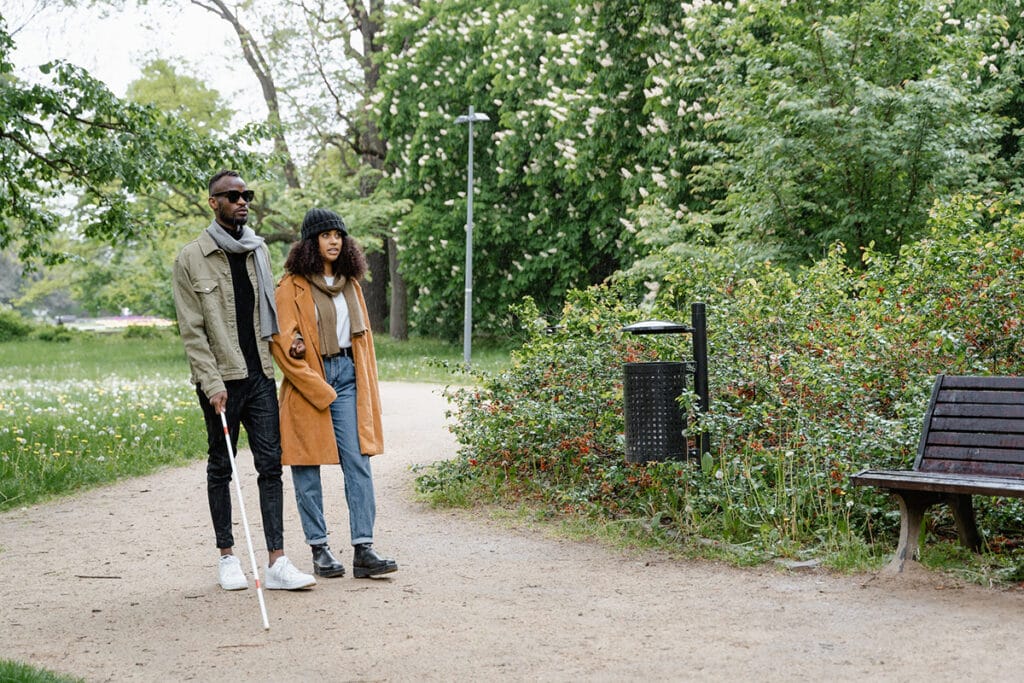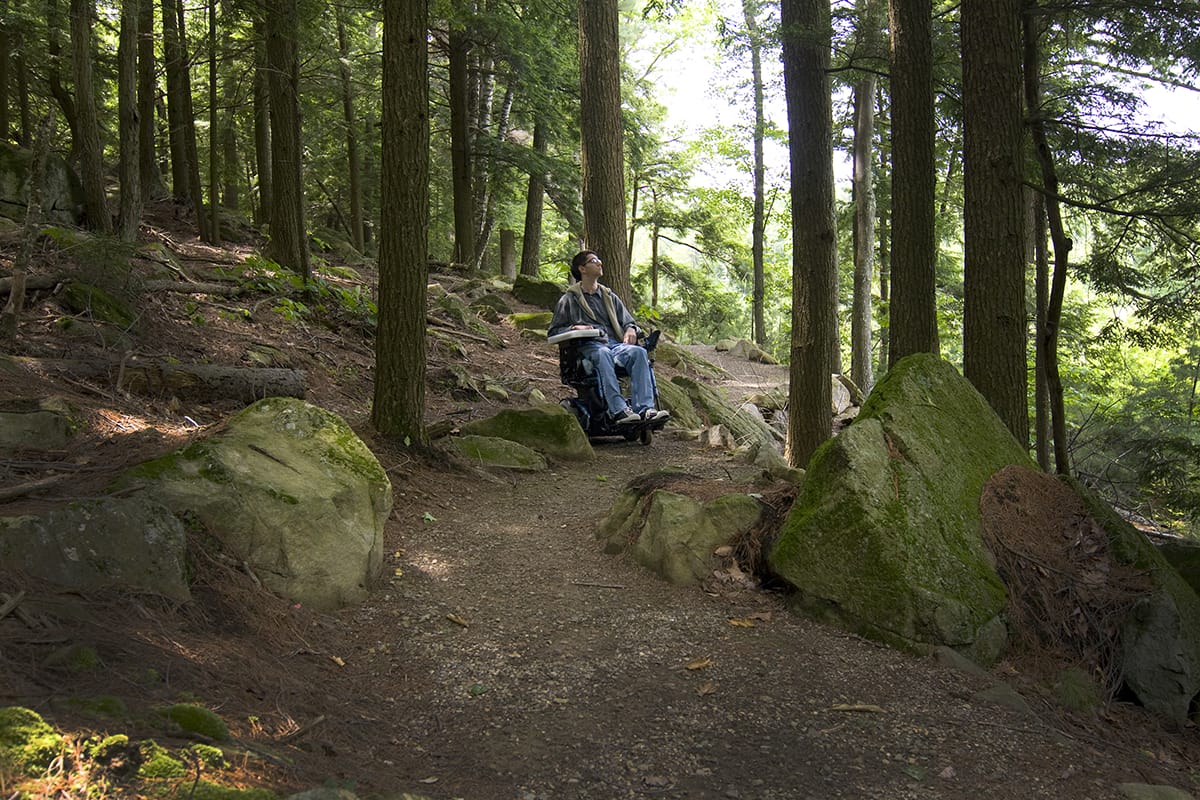At Panorama Park in Colorado Springs, people of all abilities can’t seem to get enough of the Spinner. The play structure resembles a merry-go-round that someone pushes from the outside to make it spin. But unlike many pieces of playground equipment, a person in a wheelchair can access it just as easily as a person on foot.
That’s because the mechanism is sunken and the surface flush with the ground, allowing everyone to embark smoothly.

Panorama Park in Colorado Springs includes a playground with seven distinct but connected play areas for climbing, swinging, sliding, sand play, sensory retreat, play mounds, and a toddler area. The Spinner is one of many features designed to be accessible to people with and without physical disabilities. Photo: Olivedia Productions
“The whole idea behind universal design is that it’s conceived in a way that’s better for everyone, no matter your ability,” says Kerry White, a landscape architect and principal of Urban Play Studio, who designed the play space. “Someone in a wheelchair or walker can roll or walk right onto it, and they sit next to kids without any physical disabilities. It’s seamless.”
The Spinner is one of many aspects of Panorama Park designed to be universally accessible. There are a variety of accessible swings, a sand table that children in wheelchairs can access, and a Quiet Nook for anyone who might need a momentary escape from the stimulation. Contrasting bands on the poured-in-place rubber play surface serve dual purposes. They define, connect, and organize the various play stations for neurodivergent children who might need the visual clues to guide their play journey, and they help guide people with visual impairments.
Lindsey Blankenship, an advocate for the disability community in Colorado, has a rare genetic retinal disease, which is causing her to lose her sight. The 43-year-old mother of two boys lives outside Denver and laments that more parks and trails don’t include simple visual or textural cues like the ones at Panorama to alert people who are visually impaired that a surface or elevation change is imminent.
“The hardest thing is when everything looks the same,” says Blankenship, president of the Colorado chapter of the Foundation Fighting Blindness and director of Creating S.P.A.C.E., an educational and professional program helping make disability a comfortable conversation. “For me, depth perception becomes an issue, so if there is no variation between gravels or the path is the same color as the steps, that’s a problem.”

Including visual or textural contrast to indicate elevation or slope changes is one design strategy to make parks and trails more inclusive for people with visual impairments. Photo: Mart Production
Navigating with her white cane, which she nicknamed “She-Ra” after the 1980s female superhero, Blankenship knows parks could be far more welcoming to everyone. “I feel like there is so much more to be done,” says Blankenship. “Parks are pretty dated.”
Trust for Public Land is working to change that. Although the Americans with Disabilities Act (ADA) sets forth design requirements, people in the disability community have long known those standards to fall short. We’re committed to connecting everyone to the outdoors, and that means partnering with people with and without disabilities, landscape architects, and park planners who prioritize inclusive design.
Donate today to help Trust for Public Land and our partners across the country imagine, fund, and create more inclusive playgrounds, parks, and trails so that everyone can experience and benefit from time outside.
One-third of Americans, including 28 million children, lack safe, easy access to a park within a 10-minute walk of home. Urge your senators to allocate funding to create parks and enhance outdoor recreational opportunities by championing the Outdoors for All Act today!
Carissa Decelles, an art director in Connecticut, has spinal muscular atrophy and has used a wheelchair since she was a young child. At age 5, she was invited to help design a fully accessible playground—complete with a tree house that was fabricated for the space. It was 40 minutes from Decelles’s home, but her mother brought her there often. “It was one of my favorite places to visit as a kid,” she says.
Now in her early 30s, Decelles still loves getting outdoors to experience nature, sometimes with her service dog, Ren, in tow. But that can be tricky. “I have a lot of friends who like to hike, and finding places where we can all go together can be difficult, which is why we tend to go to the same places over and over again,” she explains. Trails in many city and suburban areas have paved surfaces, making them naturally accessible. But rare is the rural or mountainous setting with a truly accessible trail. And, Decelles notes, a trail doesn’t have to be paved to be accessible. “One of the rail trails near me has an offshoot with compacted dirt,” she adds. “It is very flat and level and goes through the woods.”

A young man in a wheelchair stops along the 3-mile accessible summit trail on Crotched Mountain. Photo: Crotched Mountain Foundation
About a decade ago in Greenfield, New Hampshire, Trust for Public Land partnered with the Crotched Mountain Foundation on just such a trail. The foundation ran a school and treatment center—which is now owned by the Seven Hills Foundation—for children and adults with a variety of disabilities. The project protected 1,200 acres adjacent to the 200-acre campus through a conservation easement, preventing future development.
An accessible trail to the summit achieves its elevation gain through a series of switchbacks, along with pull-off areas for resting. It was designed by master trail builder Peter S. Jensen Associates of Vermont, a landscape architecture firm known for its thoughtful, accessible trail networks.
J.T. Horn, director of TPL’s national Trails initiative, says the trail is available to the wider public and has proved hugely popular among those with disabilities and those without. “I’ve been there a number of times and I frequently see people who have mobility impairments,” Horn notes. “But the people I see most are walkers without disabilities who appreciate that it’s not straight up and down, with rocks and roots. It just makes for a lovely walk.”
The 3-mile trail goes through woods and wetlands before rising gradually toward a summit overlook. “What’s unique about Crotched Mountain is that it’s more of a backcountry setting,” Horn says. “People don’t expect to be able to bring a stroller or wheelchair or walker up a mountain.” In addition, there is a lake with a large dock that allows people in wheelchairs to transfer easily to canoes or kayaks.

Until now, residents from the communities of Safford and Thatcher, Arizona, have had little access to the Gila River since properties at the river’s edge are in private hands. But in 2022, TPL, the Gila Watershed Partnership, and Graham County announced the donation of five trail easements by local landowners, clearing the way for a multiuse path, known as the Gila River Linear Park and Trail. It will extend an existing trail network.Spacious and gently curving, the new trail will combine paved and soft surfaces, accommodating children and adults with a variety of needs.
As for parks and playgrounds, a growing trend in recent years is the focus on children with developmental and cognitive disabilities. That is partly due to the rise in autism and related disorders in recent decades. The Centers for Disease Control and Prevention estimated that, in 2018, one in 44 children in the United States had autism. That was up from one in 150 in 2000.
That means that more and more children—and by extension their caregivers and often their siblings—find themselves excluded from social outdoor opportunities if their nearby parks and playgrounds are designed in ways that disable them.
Schools, summers camps, childcare centers, and, increasingly, park agencies are responding to the reality that disability is more prevalent than our built environments have historically reflected.
In the Bay Area of San Francisco, a new neighborhood park is taking shape in Ashland, an unincorporated area of Alameda County where average household income is half that of the county as a whole.
Trust for Public Land teamed with the Hayward Area Recreation and Park District to engage the community on potential designs for the park. Members of two disability-rights groups, including a parents group called Padres Guerreros, had similar items on their wish lists for Mateo Street Park, for which TPL secured more than $7 million in Proposition 68 state grant funding.
“A big ask from the community was that we consider all abilities in our design, offer a range of sensory experiences for users, and create respite opportunities within the park to combat overstimulation,” says Kira Miritano, senior program manager for TPL’s Bay Area park development team.
Hai-Ping Mo, a project manager for the Recreation and Park District, says that among the ideas for the new green space was a separate area, called a Sensory Park. The idea is to have pleasing things to touch and examine such as a tactile wall and a garden with textured plants. A path might include grooved surfacing to help people with vision difficulties navigate the space.
“That opened the conversation,” Mo says. “ADA is truly a minimum requirement, and it doesn’t necessarily make people with physical or other disabilities feel welcome. We realized there are a lot more barriers out there.”
In Connecticut, Elanah Sherman, a member of TPL’s local advisory board, says she prefers the term “maximum access” to “universal access” since, she argues, nothing can be truly universally accessible. Trails are especially vulnerable to weather damage and plant growth and, whether park or trail, “nothing works for absolutely everyone,” she points out.
Walker Holmes, the Connecticut state director and an associate vice president at TPL, says Sherman’s commitment to this issue has helped guide the team there to think more deeply and holistically about its approach to inclusivity in all aspects of their work. “We really are trying to look at this from every angle.”
For example, a project in Bridgeport, Connecticut, where TPL is undertaking a 20-mile waterfront pathway, will be “a great place to think about access to the outdoors,” Holmes says. “We are taking a careful look at whether we are being fully inclusive of people with disabilities in our community design process.”
Lisa W. Foderaro is a senior writer and researcher for Trust for Public Land. Previously, she was a reporter for the New York Times, where she covered parks and the environment.

Donate to become a member, and you’ll receive a subscription to Land&People magazine, our biannual publication featuring exclusive, inspiring stories about our work connecting everyone to the outdoors.

